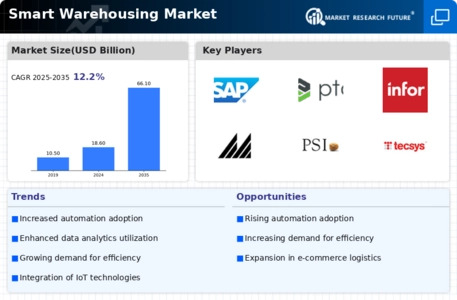-
Executive summary
-
Market Introduction
-
Definition
-
Scope of the Study
- Research Objective
- Assumptions
- Limitations
-
Research Methodology
-
Overview
-
Data Mining
-
Secondary Research
-
Primary Research
- Primary Interviews and Information Gathering Process
- Breakdown of Primary Respondents
-
Forecasting Modality
-
Market Size Estimation
- Bottom-Up Approach
- Top-Down Approach
-
Data Triangulation
-
Validation
-
Market Dynamics
-
Overview
-
Drivers
-
Restraints
-
Opportunities
-
Market Factor Analysis
-
Value Chain Analysis
-
Porter’s Five Forces Analysis
- Bargaining Power of Suppliers
- Bargaining Power of Buyers
- Threat of New Entrants
- Threat of Substitutes
- Intensity of Rivalry
-
COVID-19 Impact Analysis
- Market Impact Analysis
- Regional Impact
- Opportunity and Threat Analysis
-
GLOBAL SMART WAREHOUSING MARKET, BY Component
-
Overview
-
Hardware
-
Solutions
-
Services
-
GLOBAL SMART WAREHOUSING MARKET, BY Deployment Mode
-
Overview
-
Cloud
-
On-premises
-
GLOBAL SMART WAREHOUSING MARKET, BY Organization Size
-
Overview
-
Large Enterprises
-
Small and medium-sized enterprises (SMEs)
-
GLOBAL SMART WAREHOUSING MARKET, BY Technology
-
Overview
-
IoT and Analystics
-
AI in Warehouse
-
Automatd Guided Vehicles (AGV)
-
RFID
-
Blockchain in Warehouse
-
Other Technologies
-
GLOBAL SMART WAREHOUSING MARKET, BY Application
-
Overview
-
Transport Management
-
Inventory Management
-
Order Management
-
Yard Management
-
Shipping Management
-
Labor Management
-
Other Applications
-
GLOBAL SMART WAREHOUSING MARKET, BY Vertical
-
Overview
-
Transportation and Logistics
-
Retail and eCommerce
-
Manufacturing
-
Healthcare and Life Sciences
-
Energy and Utilities
-
Automotive
-
Food and Beverages
-
Other Verticals
-
GLOBAL SMART WAREHOUSING MARKET, by Region
-
Overview
-
North America
- U.S.
- Canada
-
Europe
- Germany
- France
- U.K
- Italy
- Spain
- Rest of Europe
-
Asia-Pacific
- China
- India
- Japan
- South Korea
- Australia
- Rest of Asia-Pacific
-
Rest of the World
- Middle East
- Africa
- Latin America
-
Competitive Landscape
-
Overview
-
Competitive Analysis
-
Market Share Analysis
-
Major Growth Strategy in the Global Smart warehousing Market,
-
Competitive Benchmarking
-
Leading Players in Terms of Number of Developments in the Global Smart warehousing Market,
-
Key developments and Growth Strategies
- New Component Launch/Deployment Mode Deployment
- Merger & Acquisitions
- Joint Ventures
-
Major Players Financial Matrix
- Sales & Operating Income, 2024
- Major Players R&D Expenditure. 2024
-
Company ProfileS
-
ORACLE CORPORATION
- Company Overview
- Financial Overview
- Components Offered
- Key Developments
- SWOT Analysis
- Key Strategies
-
IBM Corporation
- Company Overview
- Financial Overview
- Components Offered
- Key Developments
- SWOT Analysis
- Key Strategies
-
SAP SE
- Company Overview
- Financial Overview
- Components Offered
- Key Developments
- SWOT Analysis
- Key Strategies
-
PTC.
- Company Overview
- Financial Overview
- Components Offered
- Key Developments
- SWOT Analysis
- Key Strategies
-
Infor
- Company Overview
- Financial Overview
- Components Offered
- Key Developments
- SWOT Analysis
- Key Strategies
-
MANHATTAN ASSOCIATES
- Company Overview
- Financial Overview
- Components Offered
- Key Developments
- SWOT Analysis
- Key Strategies
-
PSI Logistics
- Company Overview
- Financial Overview
- Components Offered
- Key Developments
- SWOT Analysis
- Key Strategies
-
Tecsys
- Company Overview
- Financial Overview
- Components Offered
- Key Developments
- SWOT Analysis
- Key Strategies
-
Reply
- Company Overview
- Financial Overview
- Components Offered
- Key Developments
- SWOT Analysis
- Key Strategies
-
Korber AG
- Company Overview
- Financial Overview
- Components Offered
- Key Developments
- SWOT Analysis
- Key Strategies
-
Blue Yonder
- Company Overview
- Financial Overview
- Components Offered
- Key Developments
- SWOT Analysis
- Key Strategies
-
FlytBase, Inc.
- Company Overview
- Financial Overview
- Components Offered
- Key Developments
- SWOT Analysis
- Key Strategies
-
Synergy Logistics
- Company Overview
- Financial Overview
- Components Offered
- Key Developments
- SWOT Analysis
- Key Strategies
-
Appendix
-
References
-
Related Reports
-
LIST OF TABLES
-
Global Smart warehousing Market, Synopsis, 2018-2032
-
Global Smart warehousing Market, Estimates & Forecast, 2020-2034(USD BILLION)
-
GLOBAL SMART WAREHOUSING MARKET, BY Component, 2020-2034(USD BILLION)
-
GLOBAL SMART WAREHOUSING MARKET, BY Deployment Mode, 2020-2034(USD BILLION)
-
GLOBAL SMART WAREHOUSING MARKET, BY Organization Size, 2020-2034(USD BILLION)
-
GLOBAL SMART WAREHOUSING MARKET, BY Technology, 2020-2034(USD BILLION)
-
GLOBAL SMART WAREHOUSING MARKET, BY Application, 2020-2034(USD BILLION)
-
GLOBAL SMART WAREHOUSING MARKET, BY Vertical, 2020-2034(USD BILLION)
-
North America SMART WAREHOUSING MARKET, BY Component, 2020-2034(USD BILLION)
-
North America SMART WAREHOUSING MARKET, BY Deployment Mode, 2020-2034(USD BILLION)
-
North America SMART WAREHOUSING MARKET, BY Organization Size, 2020-2034(USD BILLION)
-
North America SMART WAREHOUSING MARKET, BY Technology, 2020-2034(USD BILLION)
-
North America SMART WAREHOUSING MARKET, BY Application, 2020-2034(USD BILLION)
-
North America SMART WAREHOUSING MARKET, BY Country, 2020-2034(USD BILLION)
-
North America SMART WAREHOUSING MARKET, BY Vertical, 2020-2034(USD BILLION)
-
U.S. SMART WAREHOUSING MARKET, BY Component, 2020-2034(USD BILLION)
-
U.S. SMART WAREHOUSING MARKET, BY Deployment Mode, 2020-2034(USD BILLION)
-
U.S. SMART WAREHOUSING MARKET, BY Organization Size, 2020-2034(USD BILLION)
-
U.S. SMART WAREHOUSING MARKET, BY Technology, 2020-2034(USD BILLION)
-
U.S. SMART WAREHOUSING MARKET, BY Application, 2020-2034(USD BILLION)
-
U.S. SMART WAREHOUSING MARKET, BY Vertical, 2020-2034(USD BILLION)
-
Canada SMART WAREHOUSING MARKET, BY Component, 2020-2034(USD BILLION)
-
Canada SMART WAREHOUSING MARKET, BY Deployment Mode, 2020-2034(USD BILLION)
-
Canada SMART WAREHOUSING MARKET, BY Organization Size, 2020-2034(USD BILLION)
-
Canada SMART WAREHOUSING MARKET, BY Technology, 2020-2034(USD BILLION)
-
Canada SMART WAREHOUSING MARKET, BY Application, 2020-2034(USD BILLION)
-
Canada SMART WAREHOUSING MARKET, BY Vertical, 2020-2034(USD BILLION)
-
Europe SMART WAREHOUSING MARKET, BY Component, 2020-2034(USD BILLION)
-
Europe SMART WAREHOUSING MARKET, BY Deployment Mode, 2020-2034(USD BILLION)
-
Europe SMART WAREHOUSING MARKET, BY Organization Size, 2020-2034(USD BILLION)
-
Europe SMART WAREHOUSING MARKET, BY Technology, 2020-2034(USD BILLION)
-
Europe SMART WAREHOUSING MARKET, BY Application, 2020-2034(USD BILLION)
-
Europe SMART WAREHOUSING MARKET, BY Country, 2020-2034(USD BILLION)
-
Europe SMART WAREHOUSING MARKET, BY Vertical, 2020-2034(USD
-
Germany SMART WAREHOUSING MARKET, BY Component, 2020-2034(USD BILLION)
-
Germany SMART WAREHOUSING MARKET, BY Deployment Mode, 2020-2034(USD BILLION)
-
Germany SMART WAREHOUSING MARKET, BY Organization Size, 2020-2034(USD BILLION)
-
Germany SMART WAREHOUSING MARKET, BY Technology, 2020-2034(USD BILLION)
-
Germany SMART WAREHOUSING MARKET, BY Application, 2020-2034(USD BILLION)
-
Germany SMART WAREHOUSING MARKET, BY Vertical, 2020-2034(USD
-
France SMART WAREHOUSING MARKET, BY Component, 2020-2034(USD BILLION)
-
France SMART WAREHOUSING MARKET, BY Deployment Mode, 2020-2034(USD BILLION)
-
France SMART WAREHOUSING MARKET, BY Organization Size, 2020-2034(USD BILLION)
-
France SMART WAREHOUSING MARKET, BY Technology, 2020-2034(USD BILLION)
-
France SMART WAREHOUSING MARKET, BY Application, 2020-2034(USD BILLION)
-
France SMART WAREHOUSING MARKET, BY Vertical, 2020-2034(USD
-
U.K SMART WAREHOUSING MARKET, BY Component, 2020-2034(USD BILLION)
-
U.K SMART WAREHOUSING MARKET, BY Deployment Mode, 2020-2034(USD BILLION)
-
U.K SMART WAREHOUSING MARKET, BY Organization Size, 2020-2034(USD BILLION)
-
U.K SMART WAREHOUSING MARKET, BY Technology, 2020-2034(USD BILLION)
-
U.K SMART WAREHOUSING MARKET, BY Application, 2020-2034(USD BILLION)
-
U.K SMART WAREHOUSING MARKET, BY Vertical, 2020-2034(USD
-
Italy SMART WAREHOUSING MARKET, BY Component, 2020-2034(USD BILLION)
-
Italy SMART WAREHOUSING MARKET, BY Deployment Mode, 2020-2034(USD BILLION)
-
Italy SMART WAREHOUSING MARKET, BY Organization Size, 2020-2034(USD BILLION)
-
Italy SMART WAREHOUSING MARKET, BY Technology, 2020-2034(USD BILLION)
-
Italy SMART WAREHOUSING MARKET, BY Application, 2020-2034(USD BILLION)
-
Italy SMART WAREHOUSING MARKET, BY Vertical, 2020-2034(USD
-
Spain SMART WAREHOUSING MARKET, BY Component, 2020-2034(USD BILLION)
-
Spain SMART WAREHOUSING MARKET, BY Deployment Mode, 2020-2034(USD BILLION)
-
Spain SMART WAREHOUSING MARKET, BY Organization Size, 2020-2034(USD BILLION)
-
Spain SMART WAREHOUSING MARKET, BY Technology, 2020-2034(USD BILLION)
-
Spain SMART WAREHOUSING MARKET, BY Application, 2020-2034(USD BILLION)
-
Spain SMART WAREHOUSING MARKET, BY Vertical, 2020-2034(USD
-
Rest of Europe SMART WAREHOUSING MARKET, BY Component, 2020-2034(USD BILLION)
-
Rest of Europe SMART WAREHOUSING MARKET, BY Deployment Mode, 2020-2034(USD BILLION)
-
Rest of Europe SMART WAREHOUSING MARKET, BY Organization Size, 2020-2034(USD BILLION)
-
Rest of Europe SMART WAREHOUSING MARKET, BY Technology, 2020-2034(USD BILLION)
-
Rest of Europe SMART WAREHOUSING MARKET, BY Application, 2020-2034(USD BILLION)
-
Rest of Europe SMART WAREHOUSING MARKET, BY Vertical, 2020-2034(USD
-
Asia PAcific SMART WAREHOUSING MARKET, BY Component, 2020-2034(USD BILLION)
-
Asia PAcific SMART WAREHOUSING MARKET, BY Deployment Mode, 2020-2034(USD BILLION)
-
Asia PAcific SMART WAREHOUSING MARKET, BY Organization Size, 2020-2034(USD BILLION)
-
Asia PAcific SMART WAREHOUSING MARKET, BY Technology, 2020-2034(USD BILLION)
-
Asia PAcific SMART WAREHOUSING MARKET, BY Application, 2020-2034(USD BILLION)
-
Asia PAcific SMART WAREHOUSING MARKET, BY Country, 2020-2034(USD BILLION)
-
Asia Pacific SMART WAREHOUSING MARKET, BY Vertical, 2020-2034(USD
-
China SMART WAREHOUSING MARKET, BY Component, 2020-2034(USD BILLION)
-
China SMART WAREHOUSING MARKET, BY Deployment Mode, 2020-2034(USD BILLION)
-
China SMART WAREHOUSING MARKET, BY Organization Size, 2020-2034(USD BILLION)
-
China SMART WAREHOUSING MARKET, BY Technology, 2020-2034(USD BILLION)
-
China SMART WAREHOUSING MARKET, BY Application, 2020-2034(USD BILLION)
-
China SMART WAREHOUSING MARKET, BY Vertical, 2020-2034(USD
-
Japan SMART WAREHOUSING MARKET, BY Component, 2020-2034(USD BILLION)
-
Japan SMART WAREHOUSING MARKET, BY Deployment Mode, 2020-2034(USD BILLION)
-
Japan SMART WAREHOUSING MARKET, BY Organization Size, 2020-2034(USD BILLION)
-
Japan SMART WAREHOUSING MARKET, BY Technology, 2020-2034(USD BILLION)
-
Japan SMART WAREHOUSING MARKET, BY Application, 2020-2034(USD BILLION)
-
Japan SMART WAREHOUSING MARKET, BY Vertical, 2020-2034(USD
-
India SMART WAREHOUSING MARKET, BY Component, 2020-2034(USD BILLION)
-
India SMART WAREHOUSING MARKET, BY Deployment Mode, 2020-2034(USD BILLION)
-
India SMART WAREHOUSING MARKET, BY Organization Size, 2020-2034(USD BILLION)
-
India SMART WAREHOUSING MARKET, BY Technology, 2020-2034(USD BILLION)
-
India SMART WAREHOUSING MARKET, BY Application, 2020-2034(USD BILLION)
-
India SMART WAREHOUSING MARKET, BY Vertical, 2020-2034(USD
-
SOuth Korea SMART WAREHOUSING MARKET, BY Component, 2020-2034(USD BILLION)
-
SOuth Korea SMART WAREHOUSING MARKET, BY Deployment Mode, 2020-2034(USD BILLION)
-
SOuth Korea SMART WAREHOUSING MARKET, BY Organization Size, 2020-2034(USD BILLION)
-
SOuth Korea SMART WAREHOUSING MARKET, BY Technology, 2020-2034(USD BILLION)
-
SOuth Korea SMART WAREHOUSING MARKET, BY Application, 2020-2034(USD BILLION)
-
South Korea SMART WAREHOUSING MARKET, BY Vertical, 2020-2034(USD
-
Australia SMART WAREHOUSING MARKET, BY Component, 2020-2034(USD BILLION)
-
Australia SMART WAREHOUSING MARKET, BY Deployment Mode, 2020-2034(USD BILLION)
-
Australia SMART WAREHOUSING MARKET, BY Organization Size, 2020-2034(USD BILLION)
-
Australia SMART WAREHOUSING MARKET, BY Technology, 2020-2034(USD BILLION)
-
Australia SMART WAREHOUSING MARKET, BY Application, 2020-2034(USD BILLION)
-
Australia SMART WAREHOUSING MARKET, BY Vertical, 2020-2034(USD
-
Rest of Asia PAcific SMART WAREHOUSING MARKET, BY Component, 2020-2034(USD BILLION)
-
Rest of Asia PAcific SMART WAREHOUSING MARKET, BY Deployment Mode, 2020-2034(USD BILLION)
-
Rest of Asia PAcific SMART WAREHOUSING MARKET, BY Organization Size, 2020-2034(USD BILLION)
-
Rest of Asia PAcific SMART WAREHOUSING MARKET, BY Technology, 2020-2034(USD BILLION)
-
Rest of Asia PAcific SMART WAREHOUSING MARKET, BY Application, 2020-2034(USD BILLION)
-
Rest of Asia Pacific SMART WAREHOUSING MARKET, BY Vertical, 2020-2034(USD
-
rest of the world SMART WAREHOUSING MARKET, BY Component, 2020-2034(USD BILLION)
-
rest of the world SMART WAREHOUSING MARKET, BY Deployment Mode, 2020-2034(USD BILLION)
-
rest of the world SMART WAREHOUSING MARKET, BY Organization Size, 2020-2034(USD BILLION)
-
rest of the world SMART WAREHOUSING MARKET, BY Technology, 2020-2034(USD BILLION)
-
rest of the world SMART WAREHOUSING MARKET, BY Application, 2020-2034(USD BILLION)
-
rest of the world SMART WAREHOUSING MARKET, BY Country, 2020-2034(USD BILLION)
-
Rest of world SMART WAREHOUSING MARKET, BY Vertical, 2020-2034(USD
-
Middle East SMART WAREHOUSING MARKET, BY Component, 2020-2034(USD BILLION)
-
Middle East SMART WAREHOUSING MARKET, BY Deployment Mode, 2020-2034(USD BILLION)
-
Middle East SMART WAREHOUSING MARKET, BY Organization Size, 2020-2034(USD BILLION)
-
Middle East SMART WAREHOUSING MARKET, BY Technology, 2020-2034(USD BILLION)
-
Middle East SMART WAREHOUSING MARKET, BY Application, 2020-2034(USD BILLION)
-
Middle East SMART WAREHOUSING MARKET, BY Vertical, 2020-2034(USD
-
Africa SMART WAREHOUSING MARKET, BY Component, 2020-2034(USD BILLION)
-
Africa SMART WAREHOUSING MARKET, BY Deployment Mode, 2020-2034(USD BILLION)
-
Africa SMART WAREHOUSING MARKET, BY Organization Size, 2020-2034(USD BILLION)
-
Africa SMART WAREHOUSING MARKET, BY Technology, 2020-2034(USD BILLION)
-
Africa SMART WAREHOUSING MARKET, BY Application, 2020-2034(USD BILLION)
-
Africa SMART WAREHOUSING MARKET, BY Vertical, 2020-2034(USD
-
Latin America SMART WAREHOUSING MARKET, BY Component, 2020-2034(USD BILLION)
-
Latin America SMART WAREHOUSING MARKET, BY Deployment Mode, 2020-2034(USD BILLION)
-
Latin America SMART WAREHOUSING MARKET, BY Organization Size, 2020-2034(USD BILLION)
-
Latin America SMART WAREHOUSING MARKET, BY Technology, 2020-2034(USD BILLION)
-
Latin America SMART WAREHOUSING MARKET, BY Application, 2020-2034(USD BILLION)
-
Latin America SMART WAREHOUSING MARKET, BY Vertical, 2020-2034(USD
-
LIST OF FIGURES
-
Research Process
-
Market Structure for the Global Smart warehousing Market
-
Market Dynamics for the Global Smart warehousing Market
-
Global Smart warehousing Market, Share (%), BY Component, 2024
-
Global Smart warehousing Market, Share (%), BY Deployment Mode, 2024
-
Global Smart warehousing Market, Share (%), BY Organization Size, 2024
-
Global Smart warehousing Market, Share (%), BY Technology, 2024
-
Global Smart warehousing Market, Share (%), BY Application, 2024
-
Global Smart warehousing Market, Share (%), BY Vertical, 2024
-
Global Smart warehousing Market, Share (%), by Region, 2024
-
north AMERICA: SMART WAREHOUSING MARKET, SHARE (%), BY REGION, 2024
-
Europe: SMART WAREHOUSING MARKET, SHARE (%), BY REGION, 2024
-
Asia-Pacific: SMART WAREHOUSING MARKET, SHARE (%), BY REGION, 2024
-
Rest of the world: SMART WAREHOUSING MARKET, SHARE (%), BY REGION, 2024
-
Global Smart warehousing Market: Company Share Analysis, 2024 (%)
-
ORACLE CORPORATION: FINANCIAL OVERVIEW SNAPSHOT
-
ORACLE CORPORATION: SWOT ANALYSIS
-
IBM Corporation: FINANCIAL OVERVIEW SNAPSHOT
-
IBM Corporation: SWOT ANALYSIS
-
SAP SE: FINANCIAL OVERVIEW SNAPSHOT
-
SAP SE: SWOT ANALYSIS
-
PTC.: FINANCIAL OVERVIEW SNAPSHOT
-
PTC.: SWOT ANALYSIS
-
Infor.: FINANCIAL OVERVIEW SNAPSHOT
-
Infor.: SWOT ANALYSIS
-
MANHATTAN ASSOCIATES: FINANCIAL OVERVIEW SNAPSHOT
-
MANHATTAN ASSOCIATES: SWOT ANALYSIS
-
PSI Logistics: FINANCIAL OVERVIEW SNAPSHOT
-
PSI Logistics: SWOT ANALYSIS
-
Tecsys: FINANCIAL OVERVIEW SNAPSHOT
-
Tecsys: SWOT ANALYSIS
-
Reply: FINANCIAL OVERVIEW SNAPSHOT
-
Reply: SWOT ANALYSIS
-
Korber AG: FINANCIAL OVERVIEW SNAPSHOT
-
Korber AG: SWOT ANALYSIS
-
Blue Yonder: FINANCIAL OVERVIEW SNAPSHOT
-
Blue Yonder: SWOT ANALYSIS
-
FlytBase, Inc.: FINANCIAL OVERVIEW SNAPSHOT
-
FlytBase, Inc.: SWOT ANALYSIS
-
Synergy Logistics: FINANCIAL OVERVIEW SNAPSHOT
-
Synergy Logistics: SWOT ANALYSIS









Leave a Comment